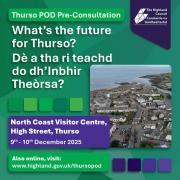Closing the attainment gap in Highland
19th October 2017
Highland Council is fully supportive of the aim to close the poverty-related educational attainment gap between children and young people from the least and most disadvantaged communities.
In Highland, 1537 Primary and 1006 Secondary School children live in the most deprived data zones.
Highland Council's focus is to target interventions to support raising attainment in reading, writing and numeracy. Schools have been supported to make best use of available funding, through existing improvement planning processes, and a ‘bureaucracy-light' approach.
The Pupil Equity Fund was launched in session 2017-18. Allocations are based on the number of pupils from P1 to S3 who are eligible and registered for free school meals, with schools receiving £1,200 per pupil. This involved 90% of Highland schools, receiving almost £4m.
Approximately 55% of Highland pupils attend the five Primary and four Secondary Schools supported directly by the Scottish Attainment Challenge (SAC) funding. There are 1646 pupils being targeted for extra interventions in these schools.
Health and Wellbeing for Families and Communities is an integral part of tackling educational attainment. Family Link Workers are making a positive difference to attendance, engagement, attitude and ultimately learning in each of four schools.
The Positive Relationships Co-ordinator was appointed in January 2017 and initially worked with schools to establish and develop a nurturing approach. This has led to a raised awareness and understanding for all staff of the importance of social and emotional learning, and the development of a nurturing approach.
Chair of the Highland Council's People Committee, Councillor Alasdair Christie said: "Highland shares the features of many other rural authorities, in having a significant attainment gap between the highest and poorest performing pupils. The attainment challenge funding is provided to help close the gap in those schools with the highest levels of multiple deprivation. The funding model does not best suit rural schools or address rural deprivation, and I understand the Scottish Government is looking at that and will hopefully address this weakness.
"Our focus is to target interventions to support raising attainment in reading, writing and numeracy. There is large amount of quantitative and qualitative data around measuring the impact of interventions, and there are already positive signs starting to demonstrate impact. We have seen very positive results where parents have been more involved in schools and their children's education.
"Health and wellbeing of families and communities is a fundamental part of an holistic approach to improving educational achievement and the best outcomes for our young people and I am keen to see that we continue be innovative and to work hard with partners to provide the best environment for children to grow and thrive and learn in."
He added: "I welcome the constructive dialogue which has taken place between the Scottish Government and Local Authorities and the recognition of our important role in educational strategy and governance.
"However, there still remains too much uncertainty around the role of the new regional improvement collaboratives and how they will enhance the delivery of education and improve attainment.
“The last thing that parents and teachers want is another layer of bureaucracy and governance and Headteachers are particularly concerned about being given additional roles and responsibilities that may impact on learning and teaching time."
He continued: “The pace of change is very rapid and we will continue to work with the Scottish Government and other partners to ensure that education reform has the best outcomes for our children."
Wick comes in for special mention as Wick High School and Newton Park are to receive funding.
See the full report at -
https://www.highland.gov.uk/download/meetings/id/72624/item_12_closing_the_attainment_gap
Related Businesses
Related Articles
Exciting Career Opportunities With The Highland Council Now Open For Applications
# 10 December 2025 Career opportunities with The Highland Council The Highland Council is looking to fill a variety of posts relating to civil engineering and flood risk management based in locations across the area. Included are opportunities specifically for civil engineering graduates and technicians, providing the ideal job with career progression for anyone recently qualified and ready for a varied and interesting role.
What the NC500 Research Projects Are Designed to Do - and Why They Matter for the Highlands
As the North Coast 500 approaches its tenth anniversary, it has become one of Scotland's most well-known tourism success stories. The 516-mile loop around the far north of the Highlands has been celebrated internationally, marketed as a world-class road trip, and credited with transforming visitor numbers in some of Scotland’s most remote areas.Help Shape the Future of Thurso
The Highland Council is inviting people that live, work, or study in Thurso, to come along to the public consultation events to have their say. This is an opportunity to help shape the future of Thurso, to gather views and ideas.
Are Scottish Councils Quietly Reversing Outsourcing? A Look at Insourcing, Cuts and the Highland IT Shift
A notable article in the Guardian on 6 December 2025 noted the high sums being paid by London councils outsourcing services to private firms. The article starts with the reduction in council funding by UK government since 2010.Council welcomes Visitor Levy flexibility plan
The Highland Council welcomes moves by the Scottish Government to introduce greater flexibility on how it could design a Visitor Levy Scheme for consultation. The Visitor Levy (Scotland) Act 2024 currently provides local authorities with discretionary powers to implement percentage-based levies following statutory consultation.Highland Council is reaching out for views to shape its next 26/27 budget.
As it looks to set out its forthcoming priorities, the council is seeking involvement from members of the public, including businesses, community groups, parents, and young people. All their opinions are going to be crucial in deciding how Highland Council will take on its budget challenge for 2026-2027.Have your say in Thurso's future £100million investment by attending public consultation events
Thurso is to benefit from £100m investment in education and community facilities and are rolling out the first phase of public consultations on 9 and 10 December 2025. The Highland Council is inviting people that live, work, or study in Thurso, to come along to the public consultation events to have their say; this is an opportunity to help shape the future of Thurso, to gather views and ideas.Finding new owners for empty homes - Scheme launched to help return more empty homes to active use
A new online portal has been launched to bring empty homeowners together with prospective buyers or developers with the aim of facilitating more properties to be used as homes again. Covering the whole of Scotland, this builds on the success of local pilots, referred to as "matchmaker schemes".Consideration for short term let control area in Skye and Raasay
Steps towards introducing a short term let control area have been considered by Highland Council's Isle of Skye and Raasay area committee. On Monday (1 December 2025) the committee heard evidence to justify the grounds for the introduction of a Short Term Let Control Area covering all or part of Skye and Raasay.Workforce North event spotlights Highland economy
EMPLOYERS and educators from across the Highlands have gathered to hear how a new initiative is aiming to transform the region's economy. Workforce North - A Call to Action brought together business leaders and teachers from primary and secondary schools from across the Highland Council area with a wide range of partners geared towards education, learning and skills development at Strathpeffer Pavillion.
